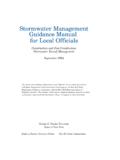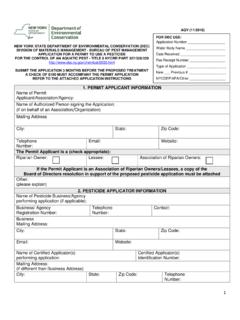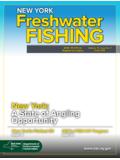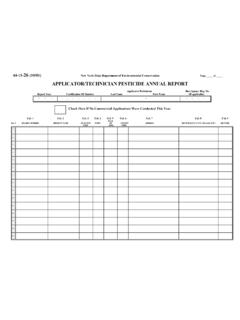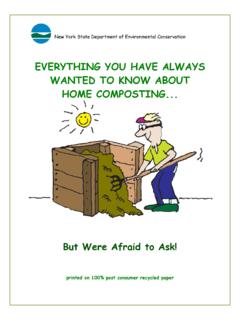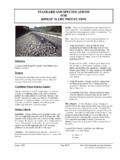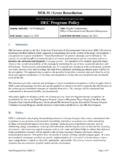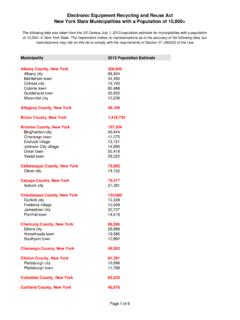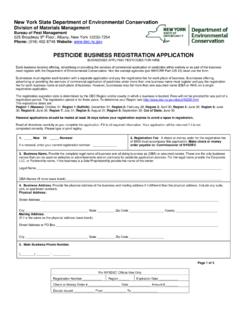Transcription of Table 4.1 New York Stormwater Sizing Criteria1
1 New York State Stormwater management Design Manual Chapter 4: Unified Stormwater Sizing Criteria Section Introduction Chapter 4: Unified Stormwater Sizing Criteria Table New York Stormwater Sizing Criteria1 . 90% Rule: WQv(acre-feet) = [(P)(Rv)(A)] /12. Water Quality Volume Rv = + (I). (WQV) Water Qualility I = Impervious Cover (Percent). P(inch) = 90% Rainfall Event Number (See Figure )2. A = site area in acres RRv (acre-feet) = Reduction of the total WQv by application of runoff reduction techniques and standard SMPs with RRv capacity to replicate pre- Runoff Reduction development hydrology.
2 Volume(RRv). The minimum required RRv is defined as the Specified Reduction Factor (S), provided objective technical justification is documented. Default Criterion: Cpv(acre-feet) = 24 hour extended detention of post-developed 1-year, 24-hour storm event; remaining after runoff reduction. Where site conditions Channel Protection allow, Runoff reduction of total CPv , is encouraged tion for Sites Larger than Volume(Cpv) 50 Acres: Distributed Runoff Control - geomorphic assessment to determine the bankfull channel characteristics and thresholds for channel stability and bedload movement.
3 Qp(cfs)=Control the peak discharge from the 10-year storm to 10-year Overbank Flood (Qp). predevelopment rates. Qf(cfs)=Control the peak discharge from the 100-year storm to 100-year Extreme Storm (Qf)h predevelopment rates. Safely pass the 100-year storm event. Design, construct, and maintain systems sized to capture, reduce, reuse, treat, Alternative method and manage rainfall on-site, and prevent the off-site discharge of the (WQv): precipitation from all rainfall events less than or equal to the 95th percentile rainfall event, computed by an acceptable continuous simulation model.
4 1 Channel protection, overbank flood, and extreme storm requirements may be waived in some instances if the conditions specified in this chapter are met. For SMPs involving dams, follow Appendix A, Guidelines for Design of Dams for safe passage of the design flood. 2 For required Sizing criteria in redevelopment projects and phosphorus limited watersheds refer to Chapters 9 and 10, respectively. 4-1. New York State Stormwater management Design Manual Chapter 4: Unified Stormwater Sizing Criteria Section Introduction Section Introduction This chapter presents a unified approach for Sizing green infrastructure for runoff reduction and SMPs to meet pollutant removal goals, reduce channel erosion, prevent overbank flooding, and help control extreme floods.
5 For a summary, please consult Table below. The remaining sections describe the Sizing criteria in detail and present guidance on how to properly compute and apply the required reduction and storage volumes. Section Water Quality Volume (WQv). The Water Quality Volume (denoted as the WQv) is intended to improve water quality by capturing and treating runoff from small, frequent storm events that tend to contain higher pollutant levels. New York has defined the WQv as the volume of runoff generated from the entire 90th percentile rain event. Essentially what this means is that a practice sized using the WQv will capture and treat 90% of all 24 hour rain events.
6 The WQv is directly related to the amount of impervious cover constructed at a site. Contour lines of the 90% rainfall event are presented in Figure The following equation can be used to determine the water quality storage volume WQv (in acre-feet of storage): . =. 12. where: WQv = water quality volume (in acre-feet). P = 90% Rainfall Event Number (see Figure ). Rv = + (I), where I is percent impervious cover A = site area in acres (Contributing area). 4-2. New York State Stormwater management Design Manual Chapter 4: Unified Stormwater Sizing Criteria Section Water Quality Volume (WQv).
7 Figure : 90th Percentile Rainfall in New York State (NYSDEC, 2013). Basis of Design for Water Quality As a basis for design, the following assumptions may be made: Measuring Impervious Cover: the measured area of a site plan that does not have permanent vegetative or permeable cover shall be considered total impervious cover. Impervious cover is defined as all impermeable surfaces and includes: paved and gravel road surfaces, paved and gravel parking lots, paved driveways, building structures, paved sidewalks, and miscellaneous impermeable structures such as patios, pools, and sheds.
8 Where site size makes direct measurement of impervious cover impractical, the land use/impervious cover relationships presented in Table can be used to initially estimate impervious cover. In site specific planning impervious cover must be calculated based the specific proposed impervious cover. 4-3. New York State Stormwater management Design Manual Chapter 4: Unified Stormwater Sizing Criteria Section Water Quality Volume (WQv). Table Land Use and Impervious Cover(Source: Cappiella and Brown, 2001). Land Use Category Mean Impervious Cover Agriculture 2. Open Urban Land* 9.
9 2 Acre Lot Residential 11. 1 Acre Lot Residential 14. 1/2 Acre Lot Residential 21. 1/4 Acre Lot Residential 28. 1/8 Acre Lot Residential 33. Townhome Residential 41. Multifamily Residential 44. Institutional** 28-41%. Light Industrial 48-59%. Commercial 68-76%. * Open urban land includes developed park land, recreation areas, golf courses, and cemeteries . ** Institutional is defined as places of worship, schools, hospitals, government offices, and police and fire stations Aquatic Resources: More stringent local regulations may be in place or may be required to protect drinking water reservoirs, lakes, or other sensitive aquatic resources.
10 Consult the local authority to determine the full requirements for these resources. 4-4. New York State Stormwater management Design Manual Chapter 4: Unified Stormwater Sizing Criteria Section Runoff Reduction Volume (RRv). SMP Treatment: The final WQv, remaining after application of runoff reduction Sizing criterion, shall be treated by an acceptable practice from the list presented in this manual. Please consult Chapter 3 for a list of acceptable practices . Determining Peak Discharge for WQv Storm: When designing flow splitters for off-line practices , consult the small storm hydrology method provided in Appendix B.
